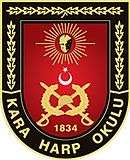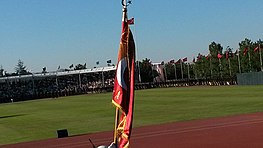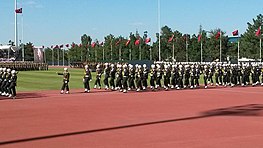Turkish Military Academy
The Turkish Military Academy (Turkish: Kara Harp Okulu) is a four-year co-educational military academy located in the center of Ankara, Turkey. Its mission is to develop cadets mentally and physically for service as commissioned officers in the Turkish Army.
Kara Harp Okulu | |
 | |
| Motto | "Yıldızların İrfan Yuvası" |
|---|---|
| Type | Military Academy |
| Established | 1834 |
| Chancellor | Brigadier General Murat Yetgin |
| Vice-Chancellor | Colonel Taner Altınok |
| Students | 4,000 future commissioned officers in the Turkish Army. |
| Location | , |
| Colors | Bordeaux and Black |
| Website | Kara Harp Okulu |
Other Military Colleges
It is not to be confused with Ottoman Military College, Army War College (Kara Harp Akademisi),[1] Armed Forces College, (Silahlı Kuvvetler Akademisi)[2] or the National Security College (Milli Güvenlik Akademisi).[3]
History




In recognition of intense demands of science and technology on modern warfare, the Ottoman State abolished the Janissaries and founded the Military Academy in Istanbul in 1834 as an institution devoted to the arts and science of warfare by the order of Sultan Mahmud II. The Academy produced its first graduates in 1841. After the foundation of military high schools in 1845, the Academy continued to give education with a four-year curriculum. The Academy had primarily trained artillery and cavalry officers until 1908.[4]
The Military Academies that were founded in five army centers in Adrianople (now known as Edirne in English), Manastır (now Bitola, North Macedonia), Erzincan, Damascus and Bagdad were closed after a short while. Later, only the Military Academy in Constantinople continued education and training.[4]
By applying an intensive training program to train soldiers for the fronts during the consecutive war periods, Turkish Military Academy (TMA) started training and education on 1 July 1920 in Abidin Pasha Mansion in Ankara during the Truce Period. TMA produced its first graduates on 1 November 1920. Atatürk hereby penned down his feelings in the book of honor: "Turkish Grand Assembly is pleased to see that the first officers of independence who are trained with the national oath of ‘Either independence or death!’ are introduced to our nation and entrusted with their missions."[4] Following the Lausanne Treaty, TMA started education in Constantinople (known in English as Istanbul after 1930) again.
Having been transferred to Ankara, the TMA started education in a new building on 25 September 1936. Academy's two-year education period was rearranged as to be a three-year education in 1948, two years in 1963, three years in 1971, and finally four years in 1974.
While TMA offered bachelor’s degree in Mechanical Engineering, Civil Engineering, Electrical and Electronics Engineering, Administration/Management between the years 1974-1991, the Academy made a gradual transition to Systems Engineering program. Systems Engineering Program produced its first graduates in 1994. With the Army Regulation for the Military Academies that was passed on 11 May 2000 in the Turkish Grand National Assembly, TMA was recognized as a higher education institution and thus, this served as a basis for the TMA to be organized in a university structure as a contemporary higher education institution.
The construction of the monument has started September 1995 and it was opened on October 8th, 1997.[5]
Alumni
Mustafa Kemal Atatürk graduated from Manastır Military High School being top of his class with another cadet, Ahmet Tevfik from Selanik, who had the same grades as him, in mid-December in 1898, and thus completed secondary education. Until mid-March in 1899, he had been on-leave. He boarded a ship in Selanik to travel to İstanbul, the capital city at that time, to continue his education in Military Academy. He left Macedonia where he had spent all his childhood and early teenage years for the first time. His enrollment in Military Academy, where he would build up a new life and, his thoughts and his personality world mature, was on 1 March 1315-13 March 1899. His epaulet number was 1283. Cadet Mustafa Kemal was recorded as "tall, white skinned Mustafa Kemal 96", son of Ali Rıza Efendi, who was one of the customs officers coming from Kasım Paşa District in Selanik, and was written down into the enrollment book which was intended for "1315 enrollments." In the book, he was between 1282 Ahmet Tevfik Efendi from Selanik (96) and 1284 Recep Fahri from Manastir Vilayet (95). In that year, Mustafa Kemal was in the first section of the first grade comprising six sections which might have had over 900 or 736 cadets according to different sources.
The commander of the Military Academy was General Mustafa Zeki. He was the commander who served most, for 22 years, between 1884 and 1906. He was a wise commander. He would read and write a lot. In order to educate patriotic officers, he worked hard and cared about the cadets. He graduated many famous commanders like Mustafa Kemal, İsmet İnönü, Kazım Karabekir and Fevzi Çakmak. In addition to General Mustafa Zeki, that General Goltz's being "the inspector for military schools" and General Esat's (Bültani) being the school principal provided the necessary foundation to make the curriculum modern. They redesigned the curriculum after having examined the curriculums in German, French and Belgium schools. Then, The Military Academy had been transformed in education and training. Probably, Mustafa Kemal and his fellow soldiers’ biggest chance was their enrollment in this new period.
Entry process
There are roughly 4,000 cadets attending the Turkish Military Academy at any one time. In order to enter the academy, prospective cadets first apply to military high school after primary schooling. Only students displaying the potential to become officers are accepted. There are three military high schools in Turkey. Maltepe Military High School in İzmir, Kuleli Military High School in Istanbul and Işıklar Military High School in Bursa. Each military high school has a four-year program, and after completion, cadets from all three schools enter the Academy. A small number of cadets also enter the school from civilian high schools. Military high schools are all male schools, so all female cadets at the Academy come from civilian high schools. The Academy is the only source of commissioned officers for the Turkish Army. After graduation, cadets are required to serve for 15 years.
Organization
The academy is made up of one regiment and four battalions, or (Turkish Tabur for singular, Taburlar for plural, and Taburu in singular-possessive constructions (like in Battalion of Izmir, which would be Izmir Taburu)), named after famous campaigns during the Turkish War of Independence (except Malazgirt). 1st Battalion is the Anafartalar Battalion, 2nd is the Dumlupinar Battalion, 3rd is the Sakarya Battalion and 4th is the Battle of Manzikert. Each battalion has a separate building, which contains a number of facilities including barracks, dining halls, classrooms, day rooms and study rooms. The cadet regiment has a cadet chain of command which rotates during the school year. The cadet regiment also has a chain of command of regular army officers in mentoring and leadership roles. The academy's regimental commander is a very prestigious position and usually precludes a higher position within the Turkish Army.
The cadets are distinguishable and organized by their graduating class as well as their cadet unit. In their classroom uniform, each cadet wears a thin gold bar on their epilate for each year they have been at the academy. Senior cadets, with four bars, also wear the color of the branch of the Turkish Army that they will be entering upon graduation on their collar. For example, green for infantry and gray for armor. The under three classes wear blue on their collar which signifies that they have not yet chosen a branch. The cadet also wears an identification number, a four digit number issued upon entrance to the academy. Atatürk's cadet number, 1283,[6] has been reserved and will not be issued to another cadet. The cadet dress uniform is the same as the Turkish Army officer's uniform, except for the addition of two gold cords looped from the right shoulder across the front right suspending two metal pins. One pin is long, and symbolizes peace while the other is short and symbolizes war.
See also
| Wikimedia Commons has media related to Turkish Military Academy. |
- Turkish Air Force Academy
- Turkish Naval Academy
- Turkish National Police Academy
References
- Army War College in the official website of the Turkish General Staffs War Colleges Command.
- Armed Forces College in the official website of the Turkish General Staffs War Colleges Command.
- National Security College in the official website of the Turkish General Staffs War Colleges Command.
- "History of Turkish Military Academy (TMA)". Turkish Military Academy. Retrieved 3 April 2017.
- Okulu, Kara Harp. "Kara Harp Okulu". www.kho.edu.tr. Retrieved 1 April 2016.
- Cadet 1283 Mustafa Kemal in the official website of the Turkish Military Academy.